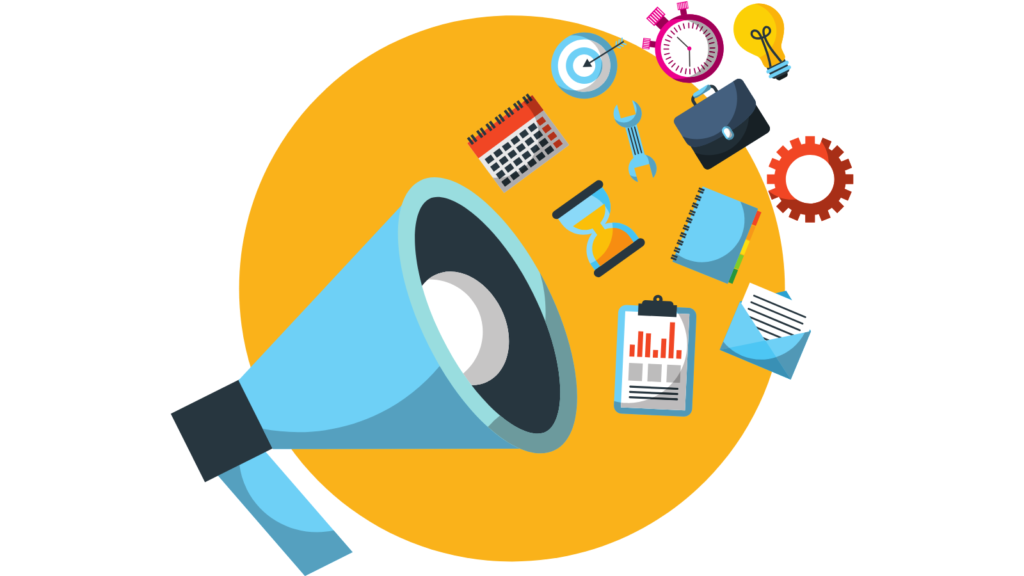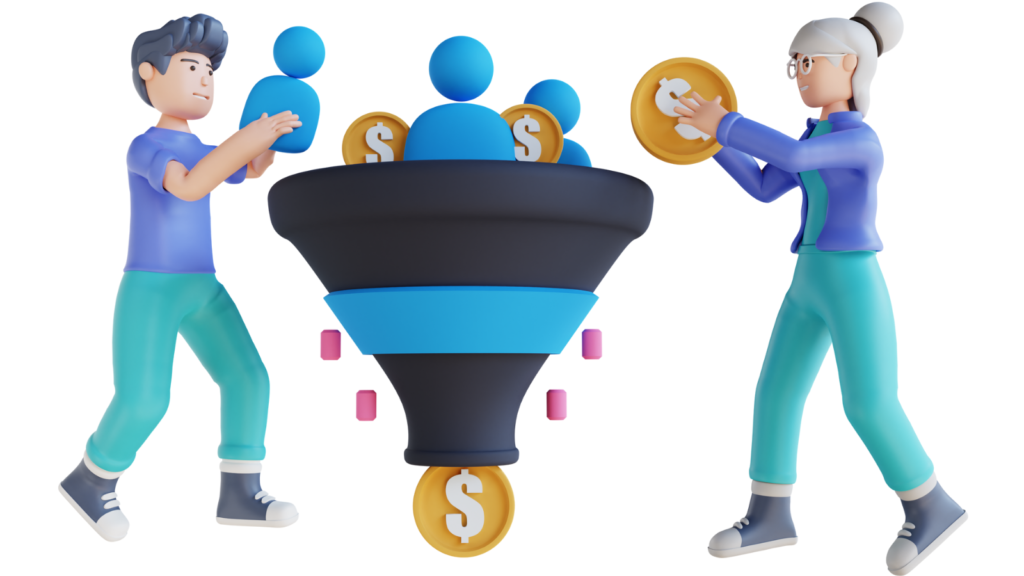
This wealth of data, often amplified by the fact that virtual events attract about four times the number of attendees compared to in-person events, provides numerous opportunities to measure and enhance your event’s success.
By strategically utilizing these data points and insights, marketers can not only seamlessly integrate events into their overall marketing strategy, but also enjoy a significant increase in ROI.
To effectively leverage virtual event analytics, it’s essential to identify the key metrics you want to track and understand how to utilize them.
H2: Role of Metrics and Analytics in Demystifying Audience Data
In B2B marketing, understanding your audience is essential for creating effective strategies and achieving business goals. Metrics play a crucial role in this process by providing valuable insights into audience behavior, preferences, and engagement. Here’s how metrics and analytics help us better understand our audience data:
- Accurate Audience Profiling: Metrics help us gather detailed information about our audience, such as demographics, interests, and behavior patterns. This data is essential for creating accurate audience profiles or personas, which in turn, enable us to tailor our marketing messages and campaigns to meet the specific needs and preferences of our target audience.
- Enhanced Personalization: By analyzing audience data, we can understand what content resonates most with our audience. This insight allows us to personalize our marketing efforts, offering content and experiences that are more relevant and valuable to them. Personalized interactions increase the likelihood of conversion and help build stronger and sustained relationships with our audience.
- Improved Lead Qualification: Metrics help us identify high-quality leads by tracking their touchpoints, engagement levels and interactions. For example, if an attendee participates actively in webinars, downloads multiple resources, or frequently engages with our content, they are more likely to be a qualified lead. This information helps the sales team prioritize their efforts and focus on leads that have a higher chance of conversion.
- Better Resource Allocation: Identifying which marketing channels and strategies yield the best results allows us to allocate resources more effectively. Metrics provide insights into which campaigns drive the most traffic, generate the highest engagement, and convert the most leads. This knowledge helps optimize marketing spend and maximize ROI.
- Data-Driven Decision Making: Metrics provide concrete data that can be used to make informed decisions. Instead of relying on intuition or guesswork, marketers can use metrics to test hypotheses, measure the impact of different strategies, and tweak campaigns based on what works best. This approach leads to more effective and impactful marketing campaigns.
Key Data Points to Track for Successful B2B Virtual Events
Analytics serves as the backbone for strategic decision-making in virtual event management. By leveraging data, organizers can optimize every aspect of the event, from marketing and audience engagement to content delivery and post-event follow-up.
1. Audience Characteristics
Audience characteristics involve collecting detailed information about your attendees, such as their roles, pain points, and interests. This data helps tailor the event experience to meet their specific needs, enhancing engagement and relevance. By understanding who your audience is and what they care about, you can create more personalized content and interactions.
- Before the Event: Include optional fields on the registration form to gather information about attendee designation, company, company size and any other data point that will help you gather audience insights.
- During the Event: Use the data gathered before the event to recommend relevant sessions, chat groups, and breakout activities that align with participants’ interests. Also, make sure your virtual event platform gathers all the in-event engagement metrics, which you will use subsequently.
- After the Event: Combine registration data with engagement data to create detailed attendee profiles. Import this information into your CRM for lead qualification and more personalized follow-up.
2. Social Media Engagement
Social media engagement analytics tracks interactions on social media platforms related to your event, including likes, shares, comments, and mentions. This metric helps measure the event’s reach and impact on social media.
- Before the Event: Promote your event actively on social media and encourage followers, event speakers and other influencers to share and engage with your posts.
- During the Event: Use live-streaming functionality of your event platform, post live updates and other interactive content to keep the conversation going on social media.
- After the Event: Analyze social media metrics to assess the event’s reach and identify which channel, what type of posts, etc made the most impact. Use these insights to refine your social media strategy for future events.
3. Lead Generation
Lead generation metrics track the number of new leads generated at the event. This includes the number of contacts collected, demo requests, and meeting schedules. This metric is crucial for measuring the event’s impact on your sales pipeline and ultimately, on your ROI.
- Before the Event: Set clear goals for lead generation and design registration forms to capture necessary lead information.
- During the Event: Encourage attendees to take action, such as requesting a demo or scheduling a meeting.
- After the Event: Analyze lead generation data to understand the event’s effectiveness in driving new business. Follow up with leads promptly to maximize conversion rates.
4. Content Download Metrics
Content download metrics track the number of times event-related content, such as whitepapers, eBooks, and presentation slides, that you have presented the event audience with, are downloaded by attendees. This helps measure the interest in your event’s educational materials.
- Before the Event: Promote the availability of valuable content to encourage registrations.
- During the Event: Highlight downloadable resources during sessions to increase engagement.
- After the Event: Analyze download data to identify popular topics and content formats. Use this information to plan future content offerings. Based on engagement data you collect, you can also share relevant resources with attendees to build a long-term association with them and push warm leads towards conversion.
5. Session Rating and Feedback
Session rating and feedback metrics capture attendees’ ratings and comments on individual sessions. This provides detailed insights into which sessions were most and least effective.
- Before the Event: Prepare session-specific feedback forms to gather detailed insights.
- During the Event: Encourage attendees to rate and provide feedback on each session.
- After the Event: Review ratings and feedback to identify high-performing sessions and areas for improvement. Use this information to plan and enhance future events.
6. Registration Source
The registration source metric tracks where your attendees are coming from, such as organic search, paid ads, email promotions, or social media. This helps you understand which channels are most effective in driving registrations and allows you to optimize your marketing spend.
- Before the Event: Tag your event promotions to identify which sources drive the most traffic and registrations.
- During the Event: Focus your social media efforts on the channels that are performing best.
- After the Event: Evaluate the performance of each channel and adjust your marketing strategy accordingly. Reduce or eliminate spending on low-performing channels and invest more in the successful ones.
7. Session Chat Engagement
Session chat engagement tracks the volume and quality of interactions in the chat during sessions. High chat activity can indicate a high level of interest and engagement with the topic or presenter.
- Before the Event: Encourage attendees to participate in chats by promoting interactive sessions.
- During the Event: Monitor chat activity to gauge engagement and adjust session dynamics to foster more interaction.
- After the Event: Analyze chat logs to identify key discussion points and topics of interest, which can inform future content planning. You can also leverage chat data to identify leads and qualify them based on their interest level.
8. Content and Presenter Ratings
Content and presenter ratings provide direct feedback from attendees on the quality of the sessions and the performance of the presenters. This metric helps identify what worked well and what needs improvement.
- Before the Event: Use past ratings to understand trends and patterns and also to select popular topics and high-performing presenters.
- During the Event: Collect real-time feedback to make immediate adjustments if necessary.
- After the Event: Analyze ratings to identify strengths and weaknesses. Use this feedback to improve future events.
9. Sponsor Booth Engagement
Sponsor booth engagement metrics track how attendees interact with sponsor booths, including visits, dwell time, and content downloads. This data helps demonstrate the value of the sponsorship and can guide improvements in sponsor offerings.
- Before the Event: Design sponsor booths to be engaging and attractive to attendees.
- During the Event: Monitor booth traffic and use notifications to drive more visits to underperforming booths.
- After the Event: Provide sponsors with detailed engagement reports, including booth traffic, dwell time, and content interactions. Use this data to enhance sponsor offerings for future events.
10. Networking Activity
Networking activity metrics measure the interactions among attendees in networking sessions, such as the volume of messages and connections made. This helps understand the effectiveness of networking opportunities provided at the event.
- Before the Event: Promote networking opportunities and set up topic-based chat groups or channels.
- During the Event: Highlight active networking channels to encourage participation and connection among attendees.
- After the Event: Analyze networking activity to identify popular topics and trends. Use this data to improve networking opportunities for future events.
11. Attendee Interaction Metrics
Attendee interaction metrics track the various ways attendees engage with the event, such as participating in polls, submitting questions during Q&A sessions, and interacting in chat rooms. These metrics provide insights into the level of engagement and interest in the event.
- Before the Event: Plan interactive elements like polls and Q&A sessions to encourage participation.
- During the Event: Monitor interaction levels in real-time to gauge engagement and make adjustments as needed.
- After the Event: Analyze interaction data to identify the most engaging elements and use these insights to enhance future events.
12. Feedback Surveys
Feedback surveys collect attendees’ opinions about the event, including content quality, speaker performance, and overall experience. This metric is essential for understanding attendee satisfaction and identifying areas for improvement.
- Before the Event: Design feedback surveys that cover key aspects of the event experience.
- During the Event: Encourage attendees to complete surveys by highlighting their importance for improving future events.
- After the Event: Review survey responses to gather actionable insights. Use this feedback to make necessary changes and improve upcoming events.
13. Account-Level Analytics
Account-level analytics enable you to categorize event attendees into different segments or groups. This segmented data helps you filter out and evaluate attendees on the basis of registration parameters, time spent, attendance, and location.
- Before the Event: Review registrations to see which target accounts are attending and plan engagement strategies.
- During the Event: Encourage your sales team to interact with attendees diligently and offer personalized experiences based on account-level insights.
- After the Event: Provide detailed account-level reports to your sales & marketing teams to tailor your revenue-driven strategies.
14. Conversion Rate
The conversion rate measures the percentage of event attendees who take a desired action, such as signing up for a free trial, requesting a demo, or making a purchase. This metric is essential for understanding the event’s impact on your bottom line.
- Before the Event: Define clear conversion goals and ensure your event’s overall strategy and offerings align with these objectives.
- During the Event: Use targeted and intuitive calls-to-action to encourage attendees to convert.
- After the Event: Analyze conversion data to evaluate the event’s success in driving business outcomes. Use these insights to optimize future events.
15. Net Promoter Score (NPS)
Net Promoter Score (NPS) measures attendees’ likelihood to recommend your event to others. It provides a snapshot of overall satisfaction and potential word-of-mouth promotion.
- Before the Event: Plan for NPS surveys to be sent post-event to capture attendee feedback.
- During the Event: Create an engaging and valuable experience to ensure high satisfaction.
- After the Event: Collect and analyze NPS score to understand attendee loyalty and satisfaction. Use this feedback to make improvements and increase future event recommendations.
16. Session Attendance
Session attendance metrics track the number of unique visitors to each session, helping you identify which topics are most and least popular. This information is crucial for understanding attendee interests and planning future content.
- Before the Event: Use past attendance data to plan sessions on topics that are likely to attract high interest.
- During the Event: Monitor live attendance to identify and promote less popular sessions in real-time.
- After the Event: Analyze session attendance to understand which topics resonated most with your audience and plan future content accordingly.
17. Session Dwell Time
Session dwell time measures how long attendees stay in each session, indicating how engaging the content is. Longer dwell times generally reflect higher engagement and interest in the topic.
- Before the Event: Plan sessions to ensure they are engaging and relevant to your audience.
- During the Event: Use real-time analytics to monitor dwell times and make adjustments as needed to keep sessions engaging.
- After the Event: Evaluate which sessions had the highest dwell times to understand what content was most engaging and apply these insights to future events.
18. Email Open and Click-Through Rates
Email open and click-through rates measure the effectiveness of your email marketing campaigns in driving registrations and engagement for your virtual event. High open and click-through rates indicate strong interest and effective messaging.
- Before the Event: Optimize email subject lines and content to improve open and click-through rates.
- On the day of the Event: Send final reminder emails to boost attendance and provide important last-minute event updates.
- After the Event: Analyze email performance to understand what messaging resonated best with your audience and apply these insights to future campaigns.
19. Technical Performance Metrics
Technical performance metrics track the quality and reliability of your virtual event platform, including stream quality, load times, and technical issues encountered by attendees. Ensuring a smooth technical experience is crucial for attendee satisfaction.
- Before the Event: Test your platform thoroughly to identify and address potential technical issues.
- During the Event: Monitor technical performance in real-time to quickly resolve any lags, glitches or issues.
- After the Event: Review technical performance data to identify areas for improvement. Use this information to enhance the technical aspects of future events.

Power of Analytics in B2B Virtual Events
Virtual events that are hosted on a solid virtual event platform allow you to collect an abundance of data. From attendee participation rates to session engagement, every interaction in a virtual setting translates to valuable data points.
Analytics play a critical role in decoding this information to provide actionable insights. It helps businesses understand what worked, what didn’t, and how to enhance the attendee experience – all of which ultimately impact the quality and quantity of business opportunities for the better.
Airmeet provides granular data and powerful analytics, along with robust reporting to make your B2B virtual event marketing strategy data-driven and impactful.
Get in touch with us to understand how we can transform your virtual events, like we have for 4000+ enterprises the world over.
FAQ
Focus on defining clear objectives and understanding the target audience to tailor the content and technology used on the virtual event platform for maximum engagement.
A robust platform offers interactive features like live polling and Q&A sessions, crucial for engaging attendees and fostering interactive dialogue during marketing conferences.
Hybrid events combine the reach of virtual platforms with the intimacy of in-person interactions, ideal for engaging both remote and local attendees, enhancing the overall experience.
Evaluate platforms based on their ability to handle the scale of your event, including features like breakout rooms, networking capabilities, and integration with your tech stack, along with detailed analytics and powerful reporting capabilities.
A detailed understanding of platform capabilities ensures that the chosen technology meets all event requirements, from attendee management to content delivery, crucial for events.
The shift has led marketers to focus more on digital engagement techniques and less on logistical arrangements, allowing for broader, more diverse audience participation and streamlined event execution.




























